Property from a Private Collection, Milan Gio Ponti and Piero Fornasetti Follow Unique 'Fiori e Cammei' wardrobe circa 1950 Lithographic transfer-printed wood, teak, teak-veneered wood, painted wood, brass. 177 x 127 x 30 cm (69 5/8 x 50 x 11 3/4 in.) Together with a certificate of expertise from the Gio Ponti Archives.
Provenance Private collection, Milan Catalogue Essay Gio Ponti and Piero Fornasetti had already been collaborating together for over a decade when they created the present unique wardrobe. Ponti had discovered the work of Fornasetti at the Fifth Milan Triennale in 1933 and the architect and painter first worked together in 1940, designing furniture for the Italian glass company Fontana Arte. They went on to produce vibrant interiors for private homes, such as the sumptuous 'casa di fantasia' featured in Domus in May 1952, as well as offices and ocean liners. In 1950 they collaborated on the landmark exhibition ‘Italy at Work: Her Renaissance in Design Today,’ which travelled to twelve museums across the United States. Reflecting on his career Ponti wrote, 'If it were worthwhile to chronicle my life as an architect a chapter (beginning in 1950) could be: ‘Passion for Fornasetti.’ What does Fornasetti give me? With his prodigious printing process . . . an effect of lightness and evocative magic.' (Laura Licitra Ponti, Giò Ponti: The Complete Work, 1923-1978 , Boston, 1990, p. 274) Indeed, the present wardrobe, which once graced the entryway of a private Milan residence, has a sense of lightness and magic that belies its large dimensions and mass. Standing on just two feet, the shallow wardrobe almost feels like an extension of the wall. Fornasetti’s festoons of cameos and flowers, a decorative element traditionally applied to walls and ceilings, further blur the line between architecture and furniture. The two tall doors open to reveal six brass hangers that echo the form of the brass feet. Once closed, coats, hats, scarves, and other debris of daily life disappear from view, solving the problem of the traditional hall tree laden with clutter. Both Ponti and Fornasetti revered Italy’s cultural heritage, in particular the visual language of the Renaissance and classical art and architecture. In keeping with classical ideals of art, throughout his career Ponti sought to create forms that represented universally recognised, harmonious beauty, the 'finished form...unchangeable, unrepeatable, unique and coherent.' With his use of decorative elements, such as Fornasetti’s patterns, Ponti skirted more austere definitions of modernism held by many of his contemporaries who eschewed pattern and historical reference. These elements come together seamlessly in the present wardrobe, a perfect example of the symbiosis of these two prolific talents during the full flowering of their collaborations in the early 1950s. Read More
Property from a Private Collection, Milan Gio Ponti and Piero Fornasetti Follow Unique 'Fiori e Cammei' wardrobe circa 1950 Lithographic transfer-printed wood, teak, teak-veneered wood, painted wood, brass. 177 x 127 x 30 cm (69 5/8 x 50 x 11 3/4 in.) Together with a certificate of expertise from the Gio Ponti Archives.
Provenance Private collection, Milan Catalogue Essay Gio Ponti and Piero Fornasetti had already been collaborating together for over a decade when they created the present unique wardrobe. Ponti had discovered the work of Fornasetti at the Fifth Milan Triennale in 1933 and the architect and painter first worked together in 1940, designing furniture for the Italian glass company Fontana Arte. They went on to produce vibrant interiors for private homes, such as the sumptuous 'casa di fantasia' featured in Domus in May 1952, as well as offices and ocean liners. In 1950 they collaborated on the landmark exhibition ‘Italy at Work: Her Renaissance in Design Today,’ which travelled to twelve museums across the United States. Reflecting on his career Ponti wrote, 'If it were worthwhile to chronicle my life as an architect a chapter (beginning in 1950) could be: ‘Passion for Fornasetti.’ What does Fornasetti give me? With his prodigious printing process . . . an effect of lightness and evocative magic.' (Laura Licitra Ponti, Giò Ponti: The Complete Work, 1923-1978 , Boston, 1990, p. 274) Indeed, the present wardrobe, which once graced the entryway of a private Milan residence, has a sense of lightness and magic that belies its large dimensions and mass. Standing on just two feet, the shallow wardrobe almost feels like an extension of the wall. Fornasetti’s festoons of cameos and flowers, a decorative element traditionally applied to walls and ceilings, further blur the line between architecture and furniture. The two tall doors open to reveal six brass hangers that echo the form of the brass feet. Once closed, coats, hats, scarves, and other debris of daily life disappear from view, solving the problem of the traditional hall tree laden with clutter. Both Ponti and Fornasetti revered Italy’s cultural heritage, in particular the visual language of the Renaissance and classical art and architecture. In keeping with classical ideals of art, throughout his career Ponti sought to create forms that represented universally recognised, harmonious beauty, the 'finished form...unchangeable, unrepeatable, unique and coherent.' With his use of decorative elements, such as Fornasetti’s patterns, Ponti skirted more austere definitions of modernism held by many of his contemporaries who eschewed pattern and historical reference. These elements come together seamlessly in the present wardrobe, a perfect example of the symbiosis of these two prolific talents during the full flowering of their collaborations in the early 1950s. Read More

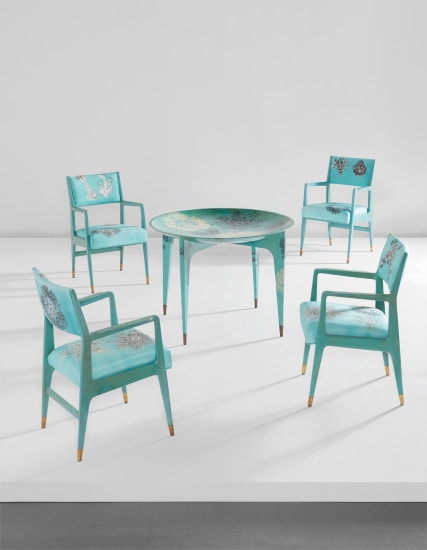
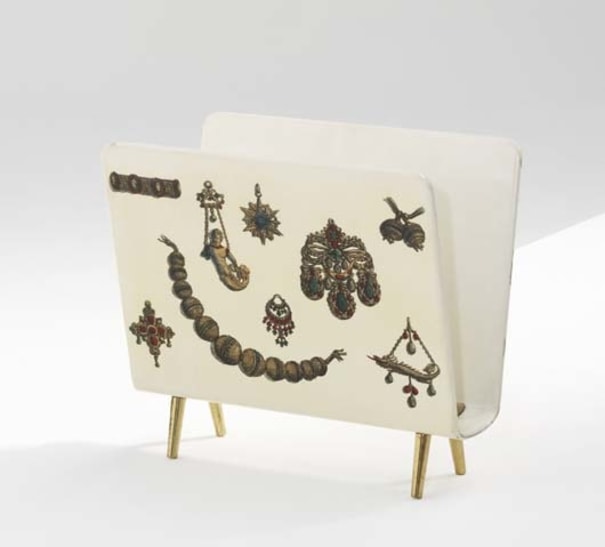
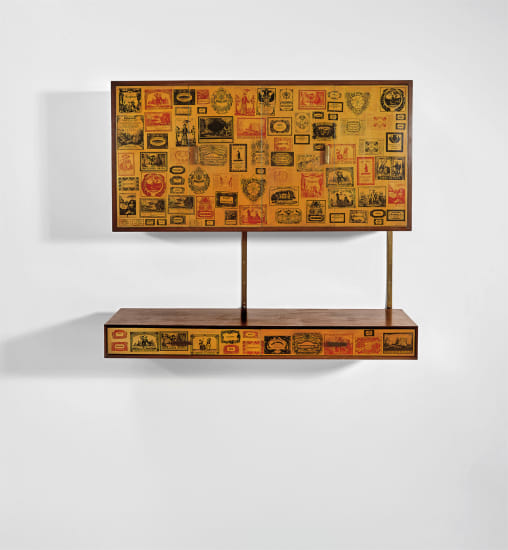
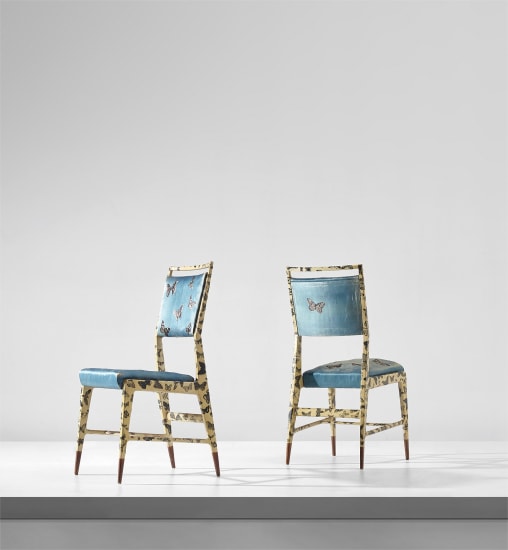
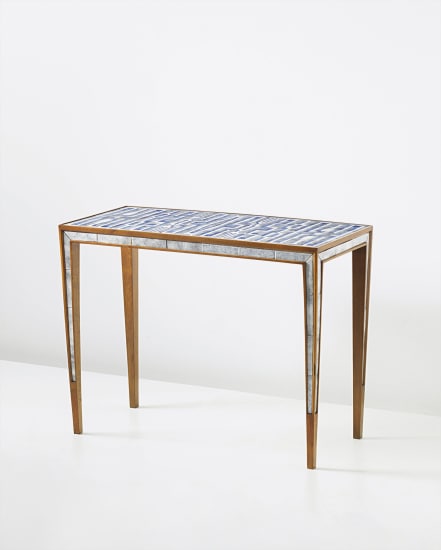

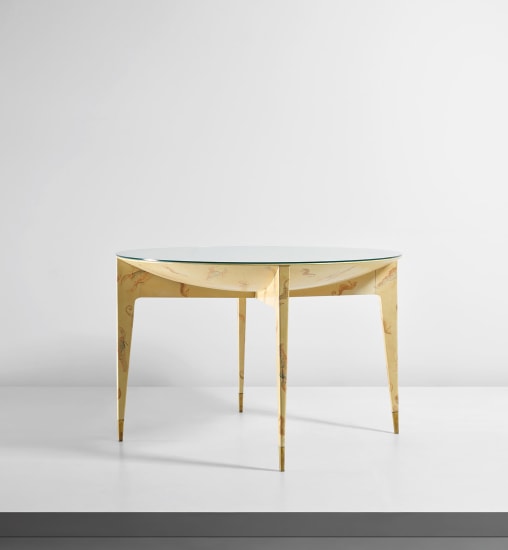


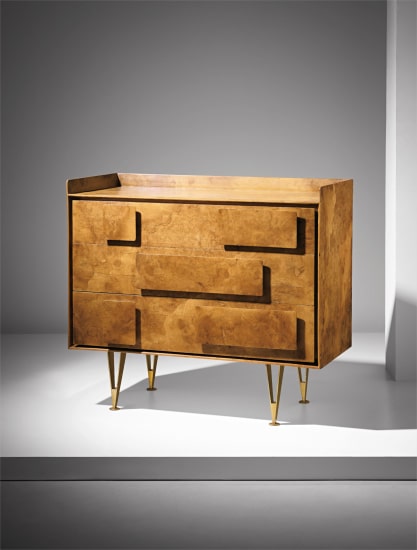

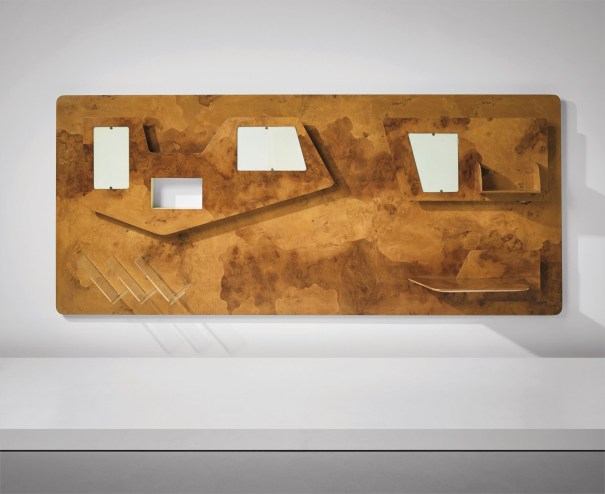
Testen Sie LotSearch und seine Premium-Features 7 Tage - ohne Kosten!
Lassen Sie sich automatisch über neue Objekte in kommenden Auktionen benachrichtigen.
Suchauftrag anlegen